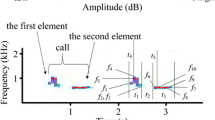Summary
The most crowded individuals in a population often compete for space and develop a regular pattern of spacing. Such regularity is not normally recognized because it occurs within high-density regions of a populated area showing overall aggregation. Thus competition for space, as reflected by spatial pattern, often goes undetected when standard tests for spatial randomness are used. The test described in this paper makes use of truncated samples of nearest-neighbour distances arranged in ascending order, so that only the pattern of spacing of the most crowded individuals is analysed. This is the basis of Pielou's test (1962, 1977) for spatial competition. An advantage of the approach described is that the density of the most crowded individuals is determined graphically. The graphical method also provides a means for choosing an appropriate, non-arbitrary, truncation point for the test. The test was applied to two samples of singing crickets to demonstrate the procedure. The biological significance of the spacing patterns identified is discussed.
Similar content being viewed by others
References
Alexander RD (1961) Aggressiveness, territoriality, and sexual behavior in field crickets (Orthoptera: Gryllidae). Behaviour 17: 130–223
Campbell DJ (1990) Resolution of spatial complexity in a field sample of singing crickets Teleogryllus commodus (Walker) (Gryllidae): a nearest-neighbour analysis. Anim Behav 39: 1051–1057
Campbell DJ, Clarke DJ (1971) Nearest neighbour tests of significance for non-randomness in the spatial distribution of singing crickets (Teleogryllus commodus (Walker)). Anim Behav 19: 750–756
Campbell DJ, Shipp E (1979) Regulation of spatial pattern in populations of the field cricket Teleogryllus commodus (Walker). Z Tierpsychol 51: 260–268
Clark PJ, Evans FC (1954) Distance to nearest neighbor as a measure of spatial relationships in populations. Ecology 35: 445–453
Hodder IR, Orton CR (1976) Spatial analysis in archaeology. Cambridge University Press, Cambridge
Huntingford FA, Turner AK (1987) Animal conflict. Chapman and Hall, London
Morris GK (1971) Aggression in male concephaline grasshoppers (Tettigoniidae). Anim Behav 19: 132–137
Otte D, Joern A (1975) Insect territoriality and its evolution: population studies of desert grasshoppers on creosote bushes. J Anim Ecol 44: 29–54
Pielou EC (1962) The use of plant to-neighbour distances for the detection of competition. J Ecol 50: 357–367
Pielou EC (1977) Mathematical Ecology. Wiley, New York
Schatral A, Latimer W, Broughton WB (1984) Spatial dispersion and agonistic contacts of male bush crickets in the biotope. Z Tierpsychol 65: 201–214
Silvertown JW (1987) Introduction to plant population ecology. Longman Scientific and Technical, New York
Thompson HR (1956) Distribution of distance to nth neighbour in a population of randomly distributed individuals. Ecology 37: 391–394
Weidemann S, Stiedl O, Kalmring K (1990) Distribution and population density of the bushcricket Decticus verrucivorus in a dampmeadow biotope. Oecologia 82: 369–373
Author information
Authors and Affiliations
Rights and permissions
About this article
Cite this article
Campbell, D.J. Nearest-neighbour graphical analysis of spatial pattern and a test for competition in populations of singing crickets (Teleogryllus commodus). Oecologia 92, 548–551 (1992). https://doi.org/10.1007/BF00317847
Received:
Accepted:
Issue Date:
DOI: https://doi.org/10.1007/BF00317847




